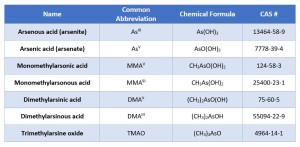We are exposed to Arsenic every single day through fruit juice, vegetables, rice and grains, dust in the air, or even by touching pressure-treated lumber. Currently, the primary recognized cause of unintentional Arsenic consumption is from drinking groundwater that contains Arsenic.
An elevated level of Arsenic in the body is believed to interfere with cellular metabolism. Arsenic poisoning produces gastroenteritis, esophageal pain, vomiting and violent diarrhea. Eventually the skin becomes cold and clammy, blood pressure drops and overall body weakness sets in. Death from circulatory failure can be sweet release from the convulsions. Large doses of Arsenic insufficient to kill will cause restlessness, nausea, vomiting, headaches, dizziness, chills, cramps, irritability and variable levels of paralysis and neuropathy that may progress over several weeks. Arsenic is also recognized as a carcinogen; there is a documented relationship between Arsenic in drinking water and the development of bladder, lung, skin, kidney, liver, prostate and nasopharyngeal cancers.
A 2007 study published by the Royal Geographic Society reported that over 137 million people in more than 70 countries are probably already affected by Arsenic poisoning from drinking water. This is not just a third world problem, Arsenic toxicity can affect us all. The USEPA has established the maximum contaminant level (MCL) of Arsenic in drinking water at 10 ppb (0.010 mg/L). This rule is enforced at over 60,000 community water systems in the United States, and adherence to the rule is required by most counties for a home to be occupied that is being served by a private water source. According to the USGS, Arsenic concentrations exceeding 10 µg/L appear to be far more frequently observed in the western United States (including Alaska) than in the eastern half.
There are seven common Arsenic species typically encountered in water:
Surface water exposed to air will generally contain Arsenic in the pentavalent +5 (oxidized) state, whereas hypoxic waters (low or no dissolved oxygen) will contain Arsenic in the trivalent +3 (reduced) state. Both are quite toxic; the trivalent is more easily assimilated by humans making it even more dangerous. Don’t be fooled into believing that only ground water contains pentavalent Arsenic though. Some species of bacteria derive energy by oxidizing various materials while reducing arsenates to form arsenites using enzymes known as arsenate reductases. There are also species of photosynthetic bacteria that can oxidize arsenites into arsenates, so remember to speciate whenever practical before attempting a treatment solution.
In this article, we’ll provide a high-level overview of one dealer’s experience addressing Arsenic for a homeowner using established technologies that are simple to install and maintain.
A young couple is preparing to build their very first home. The construction mortgage is approved, plans drawn up and their new 300ft well has been drilled. The county health department performs a routine water test and their entire world comes crashing down…they have Arsenic in their water, which will prevent them from receiving a construction permit.
The county is very specific about how the problem should be addressed:
• The designer of the treatment solution must provide proof that it is capable of delivering water to meet or exceed the EPA’s primary drinking water standards.
• The homeowner must agree to have the County Health Department test water after the system is functional and prior to an occupancy permit being issued.
• A maintenance agreement must be established to comply with the manufacturers’ recommended maintenance schedule.
• A record on the chain of title must be signed and show that the drinking water does not meet EPA primary drinking water standards without a functional treatment system.
• The onsite wastewater system must be designed to accommodate the discharge water demands of the treatment solution.
After a local Water Specialist was hired, he immediately tested the water and discovered the following contaminants of interest:
Iron – 0.221 mg/L
Manganese – 0.07 mg/L
Silica – 21.2 mg/L
pH – 7.3
Phosphate – None Detected
Turbidity – 0.2 NTU
Arsenic (unspeciated) – 0.023 mg/L
The key to effective system design is to employ a layered approach to ensure best performance and a minimum of maintenance.
The following sequence of treatment was chosen:
• 100 Micron Filter to protect downstream components. A simple filter is changed annually or as pressure drop necessitates it.
• Greensand Plus Filter to address iron and manganese in the water while also oxidizing arsenite into arsenate. This metered on-demand system cleans using Potassium Permanganate as a regenerant (~4 Oz. per cleaning). The system will clean itself after ~2,500 Gallons of domestic usage and will discharge ~80 Gallons to the onsite wastewater system when it cleans.
• 10 Micron Filter to clarify the water and protect the downstream Arsenic sorbent train from sediment loading. A simple filter is changed annually or as pressure drop necessitates it.
• Arsenic Treatment Train utilizing a hydrous metal sorbent. This dual-pass design ensures redundant performance. The recommended service interval is based upon projected exhaustion of the lead tank only. The lag tank serves as a secondary safety polish. During service, the Lead tank is replaced outright and returned to the factory for recycling.
Media exhaustion calculations indicate that the Lead tank will need replacement after approximately 6 years, based on an average of 300 GPD water usage in the home.
This system was simple for the dealer to install and passed county approval with ease. You too can help your customers with problem contaminants like Arsenic, but remember that health and lives are at stake. If you’re facing an Arsenic treatment project, don’t merely rely on articles like this to select treatment technologies, consult with a Master Water Specialist or Consulting Engineer to ensure that you don’t miss anything.
Internet resources worth viewing:
http://www.atsdr.cdc.gov/substances/toxsubstance.asp?toxid=3
http://www.epa.gov/remedytech/proven-alternatives-aboveground-treatment-Arsenic-groundwater
